Abstract
Multi Jet Fusion (MJF) is a leading technology for producing functional polymer parts. However, it still faces challenges with dimensional accuracy and removing unfused powder from complex internal geometries. First, dimensional accuracy was mapped by producing 45 identical PA12 specimens on an HP MJF 4200 printer in a 5 × 9 layout across five vertical layers. The analysis revealed a consistent pattern: parts located in the central positions of the build volume exhibited the poorest accuracy, while those near the perimeter were the most precise, regardless of their vertical height. This spatial variation is attributed to non-uniform thermal control from the printer’s adaptive lamp–thermal camera system. Second, the limits of powder removal from closed body-centered cubic (BCC) lattice structures were quantified. Using sandblasting and X-ray inspection, a strong inverse relationship was found between a lattice’s relative density and the maximum thickness that could be thoroughly cleaned of powder. For example, low-density structures (ρ = 0.07) could be cleaned up to five layers deep, whereas high-density structures (ρ = 0.39–0.47) were limited to only 1.5–1.7 layers. These findings offer actionable guidelines for optimizing part placement and designing internal lattice structures for MJF technology. The key findings are the spatial variation in dimensional accuracy in MJF printing, where the central parts are the least accurate and perimeter parts are the most precise, and the inverse relationship between a lattice’s relative density (ρ) and cleanable thickness. Specifically, low-density structures (ρ = 0.07) could be thoroughly cleaned up to five layers, while high-density ones (ρ = 0.39–0.47) were limited to approximately 1.5–1.7 layers. The layer thickness was a pre-designed parameter (2, 3, 4, and 5 layers), and powder removal was supported by using automated sandblasting followed by verification via industrial X-ray imaging.
1. Introduction
Additive manufacturing (AM) has progressed from a prototyping method to a mature production technology capable of delivering functional parts [1,2]. Its key advantages include design freedom [3], efficient material use [4], and the ability to fabricate complex geometries with integrated features [5,6]. Within polymer-based AM, powder bed fusion (PBF) processes—especially Selective Laser Sintering (SLS) and Multi Jet Fusion (MJF)—are among the most widely adopted for engineering polymers such as polyamide 12 (PA12). MJF is unique in that it employs inkjet nozzles to distribute fusing and detailing agents [7], followed by infrared heating. This approach enables high throughput and delivers parts with competitive surface quality [8,9].
Despite these benefits, AM processes still face inherent challenges. Dimensional accuracy is strongly influenced by part orientation, thermal gradients, and build position within the chamber [10,11]. Published studies [12,13] demonstrate that spatial variability frequently introduces systematic deviations in geometry and size, while other works [14,15] highlight the impact of scan strategy, layer thickness, and build orientation on both accuracy and mechanical performance [16]. Furthermore, issues such as surface roughness, anisotropic mechanical behavior, and residual stress remain persistent across AM technologies [17].
For MJF specifically, prior research has concentrated mainly on mechanical properties, powder reuse, and surface finish [18,19]. Considerably fewer studies have investigated location-dependent accuracy within the build volume [20] or the efficiency of powder removal from enclosed lattice structures [21,22,23]. These aspects are critical in industrial practice, where predictable tolerances and complete removal of unfused powder from internal cavities are essential to ensure both performance and reliability.
The present work aims to address these gaps. By linking process constraints with design strategies, this study provides practical guidelines for part placement and lattice configuration to enhance predictability and performance in MJF production [24,25].
2. Materials and Methods
The two primary limitations of the MJF process are dimensional accuracy and powder removal efficiency. To evaluate positional accuracy within the build volume, 45 identical specimens were printed on an HP (Palo Alto, CA, USA) MJF 4200 system. Each part was oriented at 20° to the xy-plane and 10° to the yz-plane, arranged in a 5 × 9 grid spanning the entire build plate and distributed over five vertical layers [26]. After printing, all parts were cooled inside the machine using the standard MJF cycle to minimize thermal stress and deformation [27].
Dimensional accuracy was assessed using a calibrated digital caliper and optical measurement system, with deviations determined by comparing measured and nominal CAD dimensions. The results were mapped to specific build coordinates to identify position-dependent accuracy trends.
The second part of the study examined powder-removal limits in closed BCC lattice structures enclosed by solid walls with defined vent openings. The relative density (ρ) was varied by changing the strut diameter, and four structure thicknesses (2–5 layers in the z-direction) were produced for each density. Powder removal was performed using automated sandblasting at a pressure of 4.4 bar and a standoff distance of 400 mm [28,29], with a constant blasting duration applied to all samples. The residual powder was evaluated using industrial X-ray imaging to confirm both complete and partial depowdering in otherwise inaccessible internal regions.
3. The Influence of Position and Settings of the 3D Printing Process on Accuracy
This part of the research aims to gain a deeper understanding of and describe the behavior of the material during the printing process using MJF technology. The transferability of the described methodology to other manufacturing technologies is obvious. The aim is to tell the cooling process and subsequent deformation, so that the knowledge gained can be applied in the design of the part, and the reason for any difference between the simulated (predicted) and actual deformation can be explained [30]. Residual heat is generated in the printing process [31], and heat is also used to sinter the material [32]. This results in deformation that can negatively affect the dimensional stability of the printed part [33,34]. By leveraging knowledge of the production and cooling processes, it is possible to accurately position parts that require higher precision, thereby minimizing deformation of these parts [35,36].
As part of the analysis, 45 samples were distributed in the print space of the HP MJF 4200 printer, measuring 380 × 284 × 380 mm. These samples were arranged in 5 layers of 9 and oriented in the printing space at an angle of 20° to the xy plane and 10° to the yz plane, as shown in Figure 1. The number of specimens was chosen based on their size and the ease of measuring deformations.
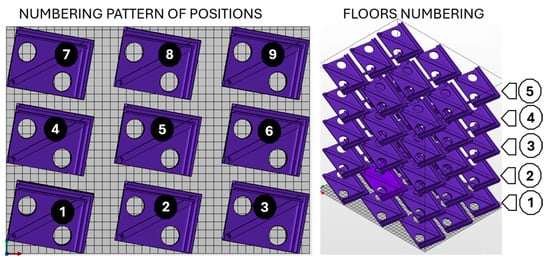
Figure 1.
Numbering of specimens in the printing area, (left)—floor 1, (right)—overall view.
Samples were numbered schematically as shown in Figure 1. The first floor is numbered 1–9, with the first sample being closest to the printer’s coordinate system and the last one being furthest away. The second floor has samples numbered 10–18, using the same system as the first floor, with sample number 10 being closest to the printer’s coordinate system and sample 18 being furthest away. The other floors are numbered similarly.
After printing the samples, the dimensions shown in Figure 2 were measured. The part was designed as a plate cover with a one-sided rib. The stacking angle and position were according to the official HP software (Version 2.0) procedure. Due to printing inaccuracies and shrinkage of the sample during cooling, there was a slight twisting of the part, which is marked as δh and should ideally be zero in an ideal state. There was also an overall shrinkage of the part, which is most noticeable in the changes in its width and length.
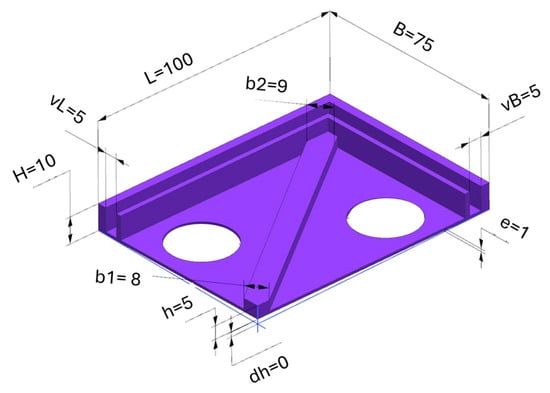
Figure 2.
Measured and analyzed dimensions selected for analysis.
The analysis of one selected dimension is presented below in Figure 3, specifically the width of part B. The overall analysis of accuracy based on the deviations of all dimensions is shown later.
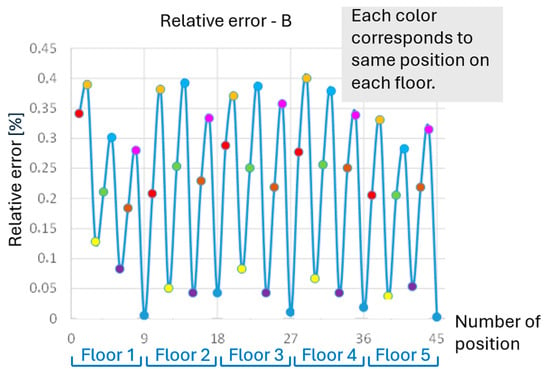
Figure 3.
Relative measured error for dimension B—example for one dimension.
The measured dimension B does not show significant differences in the accuracy of elements in individual floors. However, the greatest accuracy is always achieved by elements located in the corner positions. The worst accuracy is achieved on each floor in the middle row. Everything is evident from Figure 3 and Figure 4. The exact position of parts at all heights (on all floors) is always represented by the same color, which has a recurring effect on accuracy.

Figure 4.
Accuracy scale for each position with respect to the B dimension (example).
The accuracy of the B dimension for individual positions (quadrants) in the printer’s print space can be schematically illustrated in Figure 4, where each table represents one floor, and the color indicates the accuracy of the given position. Again, the repetition of the overall pattern across the individual floors is obvious. The total deviation from the required dimension was divided into four color-coded levels.
To understand the overall behavior of the parts and describe the deformations in all directions, a summary analysis of all measured dimensions is conducted. After processing the measurements of all dimensions, it is possible to determine the average relative error of the samples depending on their position. Figure 5 illustrates the average relative error of all measured dimensions for each position. The worst accuracies are demonstrated by the middle positions, 5, 14, 23, 32, and 41, as well as positions 8, 2, and 44. These positions should be avoided when printing parts requiring high accuracy. On the other hand, the best average results are achieved by the extreme positions, specifically at positions 12, 21, 3, and 19, and followed by positions 28, 39, 25, and 30.
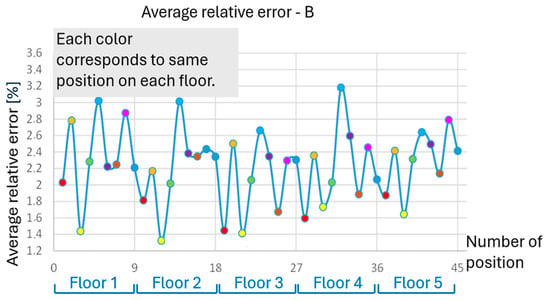
Figure 5.
Average relative error with respect to the position (floor)—overall value.
The overall accuracy of individual positions (quadrants) in the printer’s print space can be schematically illustrated in Figure 6, where each table represents one floor and the color indicates the accuracy of the corresponding position.

Figure 6.
Accuracy of specimens with respect to the position in the printing area.
Generally, the deviation across the build plate was described and considered to be 0.18 mm, with a standard deviation of 0.07 mm. Central regions showed a deviation of up to 0.25 mm, while edge regions averaged 0.12 mm. Measurements were repeated three times per dimension using a digital caliper (±0.01 mm) and an optical setup with a precision of ±0.02 mm; the overall uncertainty was ±0.03 mm.
Dimensional deviations were found to be mainly contractile, indicating uniform shrinkage during cooling. The most significant errors occurred along the x-axis, moderate errors along the y-axis, and the least significant errors along the z-axis, indicating a slight directional dependence. Central positions exhibited approximately 30–40% higher shrinkage than peripheral ones. This confirms that positional effects are systematic rather than random across the build plate.
In conclusion, the behavior observed during the printing process can be inferred from the previous results. The movement of the print heads in the longitudinal direction of the printer has a negligible effect on overall accuracy. The state of the print heads does not play a role either. In the analysis, printing lamps with a difference in operating time of the print heads of up to 200% were used, which did not show differences in the parts connected to the given head.
The worst accuracy is for parts located in the central area of the printing space, regardless of height. This effect is caused by the non-uniform distribution of temperature from the lamps. These lamps are adaptively controlled based on recordings from the thermal camera, ensuring a uniform temperature. It is clear that in the middle area, where the thermal camera (and not the lamp, see Figure 7) is located, the control of this temperature is worse, and therefore this position has the worst accuracy. This figure is crucial for understanding the source of heat during the printing process. Generally, the estimated temperature difference between the center and edges is approximately 5–10 °C, leading to local shrinkage variations of 0.05–1%. This gradient is sufficient to cause the observed dimensional inaccuracies of 0.1–0.2 mm in central positions.
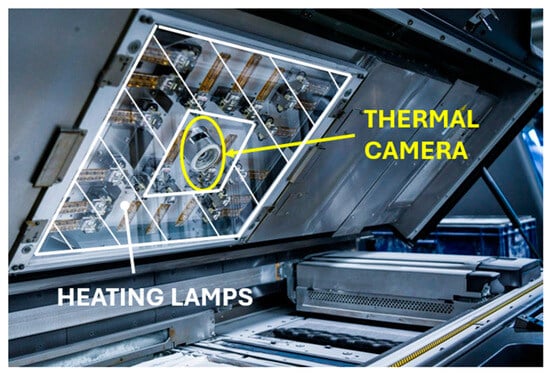
Figure 7.
MJF 4200 printer—location of heating lamps and thermal camera in the AM machine cover.
The machine does not display the temperature report to the user, as it is a closed system. There is only a simple thermal camera view, which is not easy to reproduce. In the future, machines should be equipped with a more precise thermal control system that is open to user input.
4. Limits of Lattice Structures in MJF Printing—Problems with Internal Powder Removal
One of the advantages of MJF technology is the ability to print without support structures [37]. With this technology, it is possible to use arbitrarily oriented internal fillings (it is not necessary to refer to the rules for printing without supports, as is the case with FDM technologies and the use of standard lattice structures) to relieve the parts [38,39].
However, with a closed volume, there is a problem with removing non-solid powder and achieving the primary goal of printing with internal cavities, which is to make the part lighter [40]. It is therefore necessary to determine the geometric rules for penetrations through the outer envelope surface of parts and the design of internal reinforcement structures [41] so that the removal of excess powder is possible and the requirement for weight reduction is met [42].
In this part of the work, a set of test samples was created to determine the optimal approach to designing the filling of internal cavities and penetrations in the envelope surface of the part for removing excess powder. A BCC type lattice was chosen for the internal structure, as shown in Figure 8, which can be oriented arbitrarily.

Figure 8.
Tested sample from BCC lattice cell—CAD model, (left)—one lattice cell, (right)—cross-section.
For the research, samples with different relative densities of the lattice structure were printed, and each sample was graded for thicknesses ranging from 2 to 5 layers.
The BCC lattice was selected because it is the most commonly used topology in MJF for lightweight structures, providing isotropic load paths. Other topologies, such as FCC or hexagonal lattices, generally feature smaller interconnect angles and narrower flow channels, which would reduce powder removal efficiency under identical venting and blasting conditions. For reproducibility, the BCC unit cell used in this study had an edge length of 5 mm, and the reported relative densities were calculated from this constant cell size and variable strut diameters.
The relative density depends on the diameter of the rod (which changes linearly) within the BCC lattice structure, and it is the ratio between the volume of an individual cell and the volume of a whole cube. The list of relative densities of the lattice structures of the printed samples is shown in Table 1. All parameters were selected based on the experimental setup for the given conditions.

Table 1.
Relative density with respect to the rod diameter.
After printing the samples (see Figure 9), they were sandblasted with a pressure of approximately 4.4 bar using a nozzle from a distance of 400 mm.
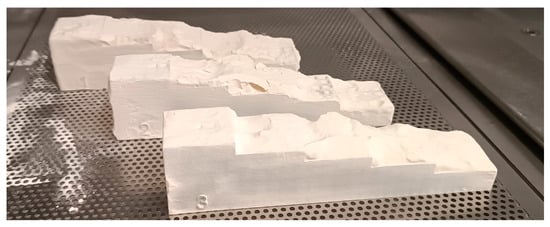
Figure 9.
Specimens before sandblasting, after the AM production process.
After sandblasting, the samples were evaluated. While, for example, for a rod thickness of 1 mm and a relative density of 0.07 (see the following Figure 10), a complete evaluation could be performed visually (the powder was removed entirely), the other samples were evaluated based on their X-ray images.

Figure 10.
Thickness of the sandblasted layer for relative cell density 0.07, rod thickness 1 mm.
The sandblasting parameters (4.4 bar, 400 mm distance) were selected based on preliminary tests that confirmed complete powder removal without strut damage, aligning with industrial depowdering guidelines for PA12 MJF parts. This setting ensured consistent comparison across samples. Alternative methods, such as ultrasonic cleaning or vacuum-assisted air blasting, could enhance powder removal in dense lattices with narrow pores; however, they may risk incomplete drying or surface erosion. These approaches could complement sandblasting for complex or high-density BCC structures.
Figure 10 shows an X-ray image of a rod with a thickness of 1 mm, corresponding to a relative density of 0.07. This image serves as a reasonable verification of the visual method, as it is clearly visible that all thicknesses were sandblasted perfectly. For the relative density of the rod, it is therefore possible to sandblast at least five layers.
For other samples, the blast depth was no longer apparent without X-rays. For example, for a sample with a rod diameter of 1.66 mm and a relative density of 0.18, it was possible to blast the first two layers completely. In contrast, for other thicknesses of 3, 4, and 5 layers, the layers were only partially blasted to a depth of approximately 2.6 layers. The blasted limit is marked with a thick white line (Figure 11).
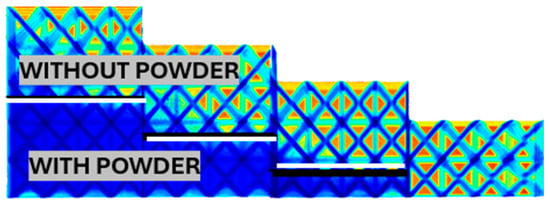
Figure 11.
Thickness of the sandblasted layer for relative cell density 0.18, rod thickness 1.66 mm.
With further increases in relative density, the thickness of the sandblasted layer decreases, as shown in Figure 12. For a rod diameter of 2.66 and a relative density of 0.39, it is possible to completely sandblast a part of the sample with a thickness of 2 layers. However, for more layers, it was not possible to achieve sandblasting of more than 1.6 layers. A thick white line again highlights the interface of the sandblasted part.
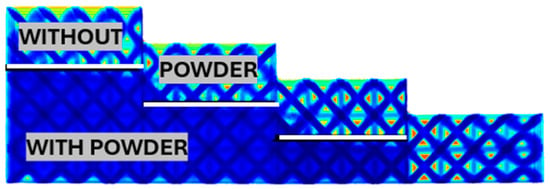
Figure 12.
Sandblasted layer thickness for relative cell density 0.39, rod thickness 2.66 mm.
The results indicate a decreasing dependence of the relative density on the sandblasted thickness, as shown in Table 2.

Table 2.
Thickness values of sandblasted layers at different relative values.
This result can be illustrated graphically (Figure 13), which shows a decrease in the dependency of the sandblasted layers on the relative density of the BCC lattice cell.
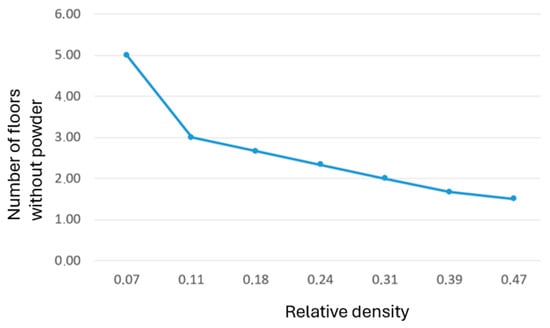
Figure 13.
Dependence of the thickness of sandblasted layers on the relative cell density.
5. Discussion
The experimental mapping of dimensional accuracy across the MJF build volume confirmed that spatial variability is a consistent and reproducible phenomenon [43]. The poorest accuracy was repeatedly observed in the central positions of each floor (e.g., positions 5, 14, 23, 32, and 41), while edge positions generally had the most minor deviations. This finding aligns with previous reports on 3D printing systems, where non-uniform thermal fields and cooling rates have been shown to affect dimensional fidelity [44,45]. In our case, the cause is attributed to the adaptive heating system of the HP MJF 4200, which regulates lamp output via a centrally located thermal camera. The central region’s more challenging thermal control likely results in localized overheating or underheating, leading to uneven shrinkage during cooling.
Notably, the observed inaccuracy patterns were largely independent of part height, indicating that horizontal location plays a more critical role than vertical build position. This suggests that designers and production engineers can consider tolerance issues by preferentially placing essential parts of peripheral zones of the build chamber. The AM machine should be equipped with a thermal output in the future to validate the thermal resolution.
The problem with removing the internal powder from parts showed a relationship between relative density and maximum cleanable thickness. At low densities (ρ ≈ 0.07), complete powder removal was achievable through up to five BCC layers, while at higher densities (ρ ≈ 0.39–0.47), only 1.5–1.7 layers could be fully cleaned. These results are consistent with findings in lattice manufacturing studies [46,47]. The industrial implication is that, for closed MJF lattices, vent design must be coupled with density and layer-thickness limitations to avoid trapped powder compromising mass reduction goals. The research has to be also focused on different types of lattice structures in the future. The BCC was chosen, because it is the most often used type of the lattice cell.
Our findings on central accuracy loss agree with [13,40], who reported similar spatial deviations in MJF and SLS builds due to uneven thermal gradients. The powder-removal behavior follows trends observed by [21,40], where higher lattice density reduced depowdering depth. Compared with these studies, our work extends the analysis by linking positional accuracy and lattice density to specific design recommendations for MJF production.
6. Conclusions
This study investigated two critical but underexplored limitations of Multi Jet Fusion technology: spatial variation in dimensional accuracy and powder removal constraints in closed lattice structures. The key conclusions are following. Dimensional accuracy varies systematically across the MJF build plate. Peripheral positions yield the most accurate dimensions, while central locations show the largest deviations, independent of height. This effect is likely linked to non-uniform heating control in the printer lid.
Powder removal in closed BCC lattices is strongly dependent on relative density and thickness. Low-density structures (ρ ≈ 0.07) allow full cleaning up to five layers, while high-density lattices (ρ ≈ 0.47) are limited to approximately 1.5 layers.
Design and production guidelines emerge directly from these findings. Critical tolerance parts should be located near chamber edges, and lattice designs should limit closed thickness according to density to ensure complete depowdering.
By quantifying these process–geometry interactions, this work provides actionable guidance for part placement and design-for-MJF strategies. The methodology can be extended to other powder-bed fusion systems to map accuracy variation and establish practical limits for internal structure cleaning.
Author Contributions
Conceptualization, K.R. and P.F.; methodology, K.R.; numerical simulations, Z.C. and P.F.; experimental data processing, Z.C. and P.F.; writing—original draft preparation, K.R. and Z.C. All authors have read and agreed to the published version of the manuscript.
Funding
This work was supported by the Grant Agency of the University of West Bohemia, grant “Long-term conceptual development of a research organization”.
Institutional Review Board Statement
Not applicable.
Data Availability Statement
Not applicable.
Acknowledgments
The article has been prepared under project “Long-term conceptual development of a research organization”.
Conflicts of Interest
The authors declare no conflicts of interest.
Abbreviations
The following abbreviations are used in this manuscript:
| MJF | Multi Jet Fusion |
| HP | Hewlett Packard |
| AM | Additive Manufacturing |
| PA | Polyamide |
References
- Osswald, P.V.; Obst, P.; Mazzei Capote, G.A.; Friedrich, M.; Rietzel, D.; Witt, G. Failure criterion for pa 12 multi-jet fusion additive manufactured parts. Addit. Manuf. 2021, 37, 101668. [Google Scholar] [CrossRef]
- Delfs, P.; Töws, M.; Schmid, H.-J. Optimized build orientation of additive manufactured parts for improved surface quality and build time. Addit. Manuf. 2016, 12, 314–320. [Google Scholar] [CrossRef]
- Lee, K.P.M.; Pandelidi, C.; Kajtaz, M. Build orientation effects on mechanical properties and porosity of polyamide-11 fabricated via multi jet fusion. Addit. Manuf. 2020, 36, 101533. [Google Scholar] [CrossRef]
- Khan, N.; Riccio, A. A systematic review of design for additive manufacturing of aerospace lattice structures: Current trends and future directions. Prog. Aerosp. Sci. 2024, 149, 101021. [Google Scholar] [CrossRef]
- Kantaros, A.; Ganetsos, T.; Piromalis, D. 3D and 4D Printing as Integrated Manufacturing Methods of Industry 4.0. Am. J. Eng. Appl. Sci. 2023, 16, 12–22. [Google Scholar] [CrossRef]
- Issabayeva, Z.; Shishkovsky, I. Prediction of The Mechanical Behavior of Polylactic Acid Parts with Shape Memory Effect Fabricated by FDM. Polymers 2023, 15, 1162. [Google Scholar] [CrossRef]
- Duvoisin, C.; Horst, D. Additive Manufacturing at Industry 4.0: A Review. Int. J. Eng. Tech. Res. 2018, 8, 3–8. [Google Scholar]
- Mehrpouya, M.; Tuma, D.; Vaneker, T.; Afrasiabi, M.; Bambach, M.; Gibson, I. Multimaterial powder bed fusion techniques. Rapid Prototyp. J. 2022, 28, 1–19. [Google Scholar] [CrossRef]
- Chan, H.K.; Griffin, J.; Lim, J.J.; Zeng, F.; Chiu, A.S.F. The Impact of 3D Printing Technology on the Supply Chain: Manufacturing and Legal Perspectives. Int. J. Prod. Econ. 2018, 205, 156–162. [Google Scholar] [CrossRef]
- Das, A.K.; Agar, D.A.; Rudolfsson, M.; Larsson, S.H. A Review on Wood Powders in 3D Printing: Processes, Properties and Potential Applications. J. Mater. Res. Technol. 2021, 15, 241–255. [Google Scholar] [CrossRef]
- Archenti, A.; Maffei, A. A novel strategy for the incorporation of optical sensors in Fused Deposition Modeling parts. In Proceedings of the International Conference on Advanced Manufacturing Engineering and Technologies NEWTECH, Stockholm, Sweden, 27–30 October 2013; Available online: https://www.diva-portal.org/smash/get/diva2:660817/FULLTEXT09.pdf#page=163 (accessed on 15 September 2023).
- Rui, L.; Weihao, C.; Zhao, J. A Review on Factors Affecting the Mechanical Properties of Additively-Manufactured Lattice Structures. J. Mater. Eng. Perform. 2023, 33, 4685–4711. [Google Scholar] [CrossRef]
- Cai, C.; Tey, W.S.; Chen, J.; Zhu, W.; Liu, X.; Liu, T.; Zhao, L.; Zhou, K. Comparative study on 3d printing of polyamide 12 by selective laser sintering and multi jet fusion. J. Mater. Process. Technol. 2021, 228, 116882. [Google Scholar] [CrossRef]
- Farkas, A.Z.; Galatanu, S.-V.; Nagib, R. The Influence of Printing Layer Thickness and Orientation on the Mechanical Properties of DLP 3D-Printed Dental Resin. Polymers 2023, 15, 1113. [Google Scholar] [CrossRef]
- Alghamdi, S.; John, S.; Choudhury, N.; Dutta, N. Additive Manufacturing of Polymer Materials: Progress, Promise and Challenges. Polymers 2021, 13, 753. [Google Scholar] [CrossRef]
- Chua, C.K.; Wong, C.H.; Yeong, W.Y. Benchmarking for Additive Manufacturing. In Standards, Quality Control and Measurement Sciences in 3D Printing and Additive Manufacturing, 1st ed.; Academic Press: Cambridge, MA, USA, 2017; pp. 181–212. [Google Scholar] [CrossRef]
- Shahrubudin, N.; Lee, T.C.; Ramlan, R. An Overview on 3D Printing Technology: Technological, Materials, and Applications. Procedia Manuf. 2019, 35, 1286–1296. [Google Scholar] [CrossRef]
- 3DPrint.com Company. HP Reveals More Info About Their Multi Jet Fusion 3D Printing Technology, Plans for Second 3D Printer, 2016. Available online: https://3dprint.com/113630/hp-multi-jet-fusion-plans-info/ (accessed on 12 October 2024).
- Farrugia, J.; Vella, P.; Rochman, A. Combining 3D printing and injection moulding for the fabrication of polymer micro-components with internal hollow features. Prog. Addit. Manuf. 2024, 9, 1353–1364. [Google Scholar] [CrossRef]
- Tawlik, M.; Nemat-Alla, M.; Dewidar, M. Enhancing the properties of aluminum alloys fabricated using wire þ arc additive manufacturing technique—A review. J. Mater. Res. Technol. 2021, 13, 754–768. [Google Scholar] [CrossRef]
- Lee, P.-H.; Chung, H.; Lee, S.W.; Yoo, J.; Ko, J. Review: Dimensional Accuracy in Additive Manufacturing Processes. In Proceedings of the ASME 2014 International Manufacturing Science and Engineering Conference, Detroit, MI, USA, 9–13 June 2014. [Google Scholar] [CrossRef]
- Alomarah, A.; Ruan, D.; Masood, S.; Gao, Z. Compressive properties of a novel additively manufactured 3d auxetic structure. Smart Mater. Struct. 2019, 28, 085019. [Google Scholar] [CrossRef]
- Kechagias, J.; Chaidas, D.; Vidakis, N.; Salonitis, K.; Vaxevanidis, N.M. Key Parameters Controlling Surface Quality and Dimensional Accuracy: A Critical Review of FFF Process. Mater. Manuf. Process. 2022, 37, 963–984. [Google Scholar] [CrossRef]
- Liu, X.; Tey, W.S.; Choo, J.Y.C.; Chen, J.; Tan, P.; Cai, C.; Ong, A.; Zhao, L.; Zhou, K. Enhancing the mechanical strength of multi jet fusion–printed polyamide 12 and its glass fiber-reinforced composite via high-temperature annealing. Addit. Manuf. 2021, 46, 102205. [Google Scholar] [CrossRef]
- Kantaros, A. 3D Printing in Regenerative Medicine: Technologies and Resources Utilized. Int. J. Mol. Sci. 2022, 23, 14621. [Google Scholar] [CrossRef]
- Li, Y.; Long, S.; Liu, Q.; Lv, H.; Liu, M. Resistive Switching Performance Improvement via Modulating Nanoscale Conductive Filament, Involving the Application of Two-Dimensional Layered Materials. Small 2017, 13, 1604306. [Google Scholar] [CrossRef]
- Atakok, G.; Kam, M.; Koc, H.B. Tensile, three-point bending and impact strength of 3d printed parts using pla and recycled pla filaments: A statistical investigation. J. Mater. Res. Technol. 2022, 18, 1542–1554. [Google Scholar] [CrossRef]
- Yelamanchi, B.; Mummareddy, B.; Santiago, C.C.; Ojoawo, B.; Metsger, K.; Helfferich, B.; Zapka, J.; Silani, F.; MacDonald, E.; Cortes, P. Mechanical and fatigue performance of pressurized vessels fabricated with multi jet fusion™ for automotive applications. Addit. Manuf. 2021, 44, 102048. [Google Scholar] [CrossRef]
- Mendricky, R.; Fris, D. Analysis of the Accuracy and the Surface Roughness of FDM/FFF Technology and Optimisation of Process Parameters. Tech. Gaz. 2020, 4, 1166–1173. [Google Scholar] [CrossRef]
- Gadelmoula, A.; Aldahash, S.A. Tribological Properties of Glass Bead-Filled Polyamide 12 Composite Manufactured by Selective Laser Sintering. Polymers 2023, 15, 1268. [Google Scholar] [CrossRef]
- Tiwari, A.S.; Yang, S. Energy Consumption Modeling of 3D-Printed Carbon-Fiber-Reinforced Polymer Parts. Polymers 2023, 15, 1290. [Google Scholar] [CrossRef] [PubMed]
- Briouza, S.; Gritli, H.; Khraief, N.; Belghith, S.; Singh, D. A Brief Overview on Machine Learning in Rehabilitation of the Human Arm via an Exoskeleton Robot. In Proceedings of the 2021 International Conference on Data Analytics for Business and Industry (ICDABI), Sakheer, Bahrain, 25–26 October 2021; pp. 129–134. [Google Scholar] [CrossRef]
- Podsiadły, B.; Skalski, A.; Rozpiórski, W.; Słoma, M. Are We Able to Print Components as Strong as Injection Molded?—Comparing the Properties of 3D Printed and Injection Molded Components Made from ABS Thermoplastic. Appl. Sci. 2021, 11, 6946. [Google Scholar] [CrossRef]
- Shim, J.S.; Kim, J.-E.; Jeong, S.H.; Choi, Y.J.; Ryu, J.J. Printing accuracy, mechanical properties, surface characteristics, and microbial adhesion of 3D-printed resins with various printing orientations. J. Prosthet. Dent. 2020, 124, 468–475. [Google Scholar] [CrossRef]
- Nowacki, J.; Sieczkiewicz, N. Problems of determination of MultiJet 3D printing distortions using a 3D scanner. Arch. Mater. Sci. Eng. 2020, 103, 30–41. [Google Scholar] [CrossRef]
- Fradl, D.; Panditaratne, J.; Bi, J.; Fu, R.; Oancea, V. Finite element simulation of the multi jet fusion (mjf™) process using abaqus. In Proceedings of the Scince of the Age of Experience conference, Boston, MA, USA, 2 May 2017. [Google Scholar]
- Mazzanti, V.; Malagutti, L.; Mollica, F. FDM 3D Printing of Polymers Containing Natural Fillers: A Review of Their Mechanical Properties. Polymers 2019, 11, 1094. [Google Scholar] [CrossRef]
- Avanzini, A.; Battini, D.; Pandini, S. Static and fatigue behavior in presence of notches for polyamide 12 (pa12) additively manufactured via multi jet fusion™ process. Int. J. Fatigue 2022, 161, 106912. [Google Scholar] [CrossRef]
- Raz, K.; Chval, Z.; Milsimerova, A. Thermal specification of 3d printed injection moulds made from pa12gb. In Proceedings of the IOP Conference Series: Materials Science and Engineering, Bardejov, Slovakia, 13–15 September 2021; Volume 1199, p. 012009. [Google Scholar] [CrossRef]
- Rosso, S.; Meneghello, R.; Biasetto, L.; Grigolato, L.; Concheri, G.; Savio, G. In-depth comparison of polyamide 12 parts manufactured by multi jet fusion and selective laser sintering. Addit. Manuf. 2020, 36, 101713. [Google Scholar] [CrossRef]
- O’Connor, H.J.; Dowling, D.P. Comparison between the properties of polyamide 12 and glass bead filled polyamide 12 using the multi jet fusion printing process. Addit. Manuf. 2020, 31, 100961. [Google Scholar] [CrossRef]
- Yang, F.; Zobeiry, N.; Mamidala, R.; Chen, X. A review of aging, degradation, and reusability of pa12 powders in selective laser sintering additive manufacturing. Mater. Today Commun. 2023, 34, 105279. [Google Scholar] [CrossRef]
- Suder, J.; Bobovsky, Z.; Mlotek, J.; Vocetka, M.; Zeman, Z.; Safar, M. Experimental analysis of temperature resistance of 3d printed pla components. MM Sci. J. 2021, 1, 4322–4327. [Google Scholar] [CrossRef]
- Geng, Z.; Bidanda, B. Geometric precision analysis for Additive Manufacturing processes: A comparative study. Precis. Eng. 2021, 69, 68–76. [Google Scholar] [CrossRef]
- Belter, J.T.; Dollar, A.M. Strengthening of 3d printed fused deposition manufactured parts using the fill compositing technique. PLoS ONE 2015, 10, e0122915. [Google Scholar] [CrossRef]
- Heitkamp, T.; Girnth, S.; Kuschmitz, S.; Waldt, N.; Klawitter, G.; Vietor, T. Experimental and Numerical Investigation of the Mechanical Properties of 3D-Printed Hybrid and Non-Hybrid Composites. Polymers 2023, 15, 1164. [Google Scholar] [CrossRef]
- Choren, J.A.; Heinrich, S.M.; Silver-Thorn, M.B. Young’s modulus and porosity relationships for additive manufacturing applications. J. Mater. Sci. 2013, 48, 5103–5112. [Google Scholar] [CrossRef]
Disclaimer/Publisher’s Note: The statements, opinions and data contained in all publications are solely those of the individual author(s) and contributor(s) and not of MDPI and/or the editor(s). MDPI and/or the editor(s) disclaim responsibility for any injury to people or property resulting from any ideas, methods, instructions or products referred to in the content. |
© 2025 by the authors. Licensee MDPI, Basel, Switzerland. This article is an open access article distributed under the terms and conditions of the Creative Commons Attribution (CC BY) license (https://creativecommons.org/licenses/by/4.0/).